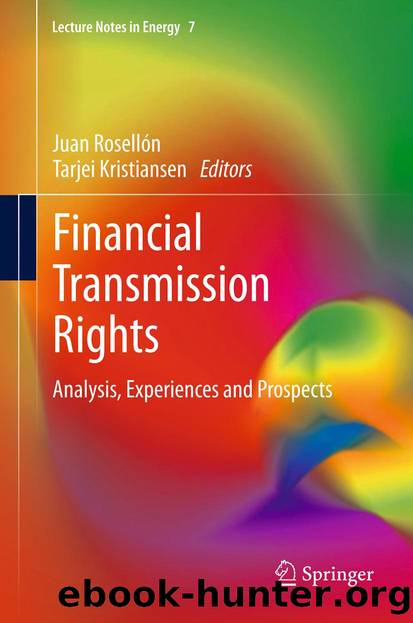Financial Transmission Rights by Juan Rosellón & Tarjei Kristiansen

Author:Juan Rosellón & Tarjei Kristiansen
Language: eng
Format: epub
Publisher: Springer London, London
8.3 Previous Experiments on Electricity Markets and Forward Contracting
A complete overview of all relevant experimental studies on electricity markets and forward contracting is beyond the scope of this chapter, and we review only the most closely related studies. For a more complete overview of experiments on electricity markets, see Kiesling (2005) or Staropoli and Jullien (2006). For a more general review of policy-oriented experimental work, see Normann and Riccuti (2009).
In our experiment, which is described in Sect. 8.4, we use uniform-price sealed-bid auctions to allocate both LTFTR and capacity on the spot market. Some other experimental studies have also studied environments modeled on electricity markets, and used auctions on either the demand or the supply side. Rassenti et al. (2003a) find that demand side bidding on a spot market successfully counteracts the exploitation of market power on the part of a network operator. Rassenti et al. (2003b) find that a uniform price auction leads to more efficient allocations than a discriminatory auction in an experimental electricity market. Noussair and Porter (1992) compare uniform-price sealed-bid auctions with highest-rejected-bid pricing and English clock auctions in an experimental electricity market, in which supply shortfalls may occur and rationing must take place ex-post. They find that the uniform price auction generates more efficient allocations than the English clock.
Other studies have considered the behavior of auctions where generators make offers to sell electricity to a power grid (see for example Denton et al. 2001; Abbink et al. 2003; and Vossler et al. 2009). This work suggests that our choice of auction would not generate undue inefficiency compared to alternative auction forms.
Two previous experimental studies focus specifically on investment in supply capacity in energy markets. They differ from our work in that they consider the generation and supply of energy rather than transport. They also differ in that they both consider an oligopolistic industry while our interest here is in a monopoly network operator. Kiesling and Wilson (2007) study an automated mitigation procedure (AMP), an alternative to a price cap, as a mechanism to control price spikes in wholesale power markets. They find that AMP does not decrease capacity investment compared to a benchmark of unregulated prices. Williamson et al. (2006) also consider investment in additional capacity in an experiment designed to study wholesale electricity markets. The market is an unregulated oligopoly. They observe investment close to the Cournot-Nash equilibrium level on average, but with a bias in the mix between marginal and baseload capacities.
There is also an experimental literature that investigates forward contracting. Krogmeier et al. (1997) and Phillips et al. (2001) compare markets, in which contracts are concluded before production. These can be thought of as forward markets. Le Coq and Orzen (2006) study an environment with an explicit forward market structure. These studies all report that a forward market is characterized by lower prices, greater quantity traded, and greater efficiency than is the case when contracting occurs on a spot market. Brandts et al. (2008) consider, in an experimental setting designed to model an electricity market, the effect of adding a forward wholesale market for electricity.
Download
This site does not store any files on its server. We only index and link to content provided by other sites. Please contact the content providers to delete copyright contents if any and email us, we'll remove relevant links or contents immediately.
Hit Refresh by Satya Nadella(8325)
The Compound Effect by Darren Hardy(7540)
Change Your Questions, Change Your Life by Marilee Adams(6632)
Nudge - Improving Decisions about Health, Wealth, and Happiness by Thaler Sunstein(6626)
The Black Swan by Nassim Nicholas Taleb(6179)
Daring Greatly by Brene Brown(5632)
Deep Work by Cal Newport(5446)
Principles: Life and Work by Ray Dalio(5312)
Rich Dad Poor Dad by Robert T. Kiyosaki(5137)
The Myth of the Strong Leader by Archie Brown(4783)
Man-made Catastrophes and Risk Information Concealment by Dmitry Chernov & Didier Sornette(4723)
Big Magic: Creative Living Beyond Fear by Elizabeth Gilbert(4713)
The Slight Edge by Jeff Olson(4711)
Discipline Equals Freedom by Jocko Willink(4626)
The Motivation Myth by Jeff Haden(4518)
Digital Minimalism by Cal Newport;(4501)
Stone's Rules by Roger Stone(4409)
Management Strategies for the Cloud Revolution: How Cloud Computing Is Transforming Business and Why You Can't Afford to Be Left Behind by Charles Babcock(4125)
The Doodle Revolution by Sunni Brown(4031)
